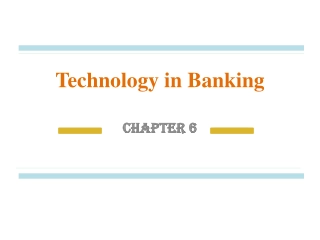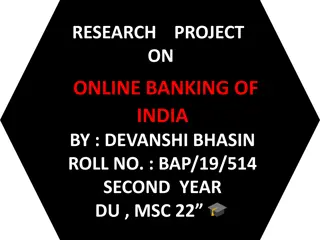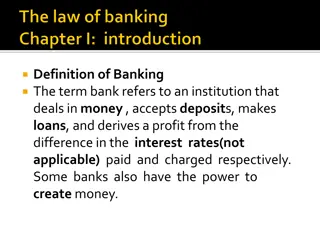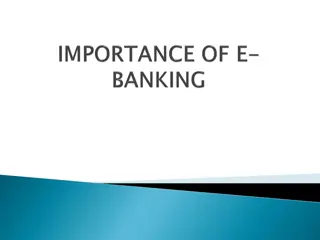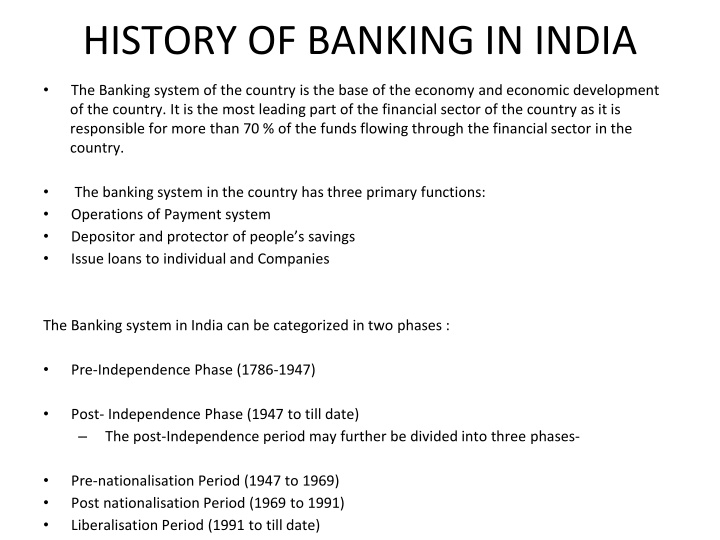
History of Banking in India: Evolution and Impact
Delve into the rich history of banking in India, spanning from the Pre-Independence era to post-Independence developments. Explore the establishment of key banks, nationalization, and the sector's transformative journey. Discover the crucial role played by banks in economic growth and development in India.
Download Presentation

Please find below an Image/Link to download the presentation.
The content on the website is provided AS IS for your information and personal use only. It may not be sold, licensed, or shared on other websites without obtaining consent from the author. If you encounter any issues during the download, it is possible that the publisher has removed the file from their server.
You are allowed to download the files provided on this website for personal or commercial use, subject to the condition that they are used lawfully. All files are the property of their respective owners.
The content on the website is provided AS IS for your information and personal use only. It may not be sold, licensed, or shared on other websites without obtaining consent from the author.
E N D
Presentation Transcript
HISTORY OF BANKING IN INDIA The Banking system of the country is the base of the economy and economic development of the country. It is the most leading part of the financial sector of the country as it is responsible for more than 70 % of the funds flowing through the financial sector in the country. The banking system in the country has three primary functions: Operations of Payment system Depositor and protector of people s savings Issue loans to individual and Companies The Banking system in India can be categorized in two phases : Pre-Independence Phase (1786-1947) Post- Independence Phase (1947 to till date) The post-Independence period may further be divided into three phases- Pre-nationalisation Period (1947 to 1969) Post nationalisation Period (1969 to 1991) Liberalisation Period (1991 to till date)
Pre-Independence Phase (1786-1947) The first bank of India was the Bank of Hindustan , established in 1770 and located in the then, Indian capital, Calcutta. However, this bank failed to work and ceased operations in 1832. During the Pre Independence period over 600 banks had been registered in the country but only a few managed to survive. Following the path of Bank of Hindustan, various other banks were established in India. They were: The General Bank of India (1786-1791) Bank of Bengal (1809) Bank of Bombay (1840) Bank of Madras (1843) During the British rule in India, The East India Company had established three banks: Bank of Bengal, Bank of Bombay and Bank of Madras and called them the Presidential Banks. These three banks were later merged into one single bank in 1921 which was called the Imperial Bank of India. The Imperial Bank of India was later nationalised in 1955 and was named The State Bank of India, which is currently the largest Public sector Bank.
Pre-Indepence Banks in India Bank Name Year of Establishment Allahabad Bank 1865 Punjab National Bank 1894 Bank of India 1906 Central Bank of India 1911 Canara Bank 1906 Bank of Baroda 1908 The central Bank of India, RBI establish in 1935 on the recommendation of Hilton-Young Commission. At that time, the Banking system was only covered the urban population and need of rural and agriculture sector was totally neglected.
If we talk of the reasons as to why many major banks failed to survive during the pre independence period, following conclusions can be drawn: Lack of machines and technology Human errors & time consuming Less facilities Lack of proper management skills Following the Pre Independence period was the post independence period which observed some major changes in the banking industry scenario and has till date developed a lot.
Post- Independence Phase -Pre- nationalisation Period (1947 to 1969) At the time independence, the entire Banking sector was under private ownership. The rural population of the country had to dependent on small money lenders for their requirements. To solve these issues and better development of the economy the Government t of India nationalised the Reserve Bank of India in 1949. In 1955 the Imperial Bank of India was nationalised and named the State Bank of India. The Banking Regulation Act enacted in 1949.
Post nationalisation Period (1969 to 1991) The Indian Banking system immensely developed after nationalisation but the rural and weaker section of the society was still not covered under the system. To solve these issues, the Narasimham Committee in 1974 recommended the establishment of Regional Rural Banks (RRB). On 2ndOctober 1975, RRBs were established with an objective to extend the amount of credit to the rural section of the society. Six more banks further nationalised in the year 1980. With the second wave of nationalisation, the target of priority sector lending was also raised to 40%.
. These banks included: Andhra Bank Corporation Bank New Bank of India Oriental Bank of Comm. Punjab & Sind Bank Vijaya Bank Apart from the above mentioned 20 banks, there were seven subsidiaries of SBI which were nationalised in 1959: State Bank of Patiala State Bank of Hyderabad State Bank of Bikaner & Jaipur State Bank of Mysore State Bank of Travancore State Bank of Saurashtra State Bank of Indore All these banks were later merged with the State Bank of India in 2017, except for the State Bank of Saurashtra, which was merged in 2008 and State Bank of Indore, which was merged in 2010.
Impact of Nationalization There were various reasons why the Government chose to nationalise the banks. Given below is the impact of Nationalising Banks in India: This lead to an increase in funds and thereby increasing the economic condition of the country Increased Efficiency Helped in boosting the rural and agricultural sector of the country It opened up a major employment opportunity for the people Profit gained by Banks was used by the Government for the betterment of the people Competition was decreased and work efficiency had increased This post Independence phase was the one that led to major developments in the banking sector of India and also in the evolution of the banking sector.
Liberalization Period (1991 to till date) Once the banks were established in the country, regular monitoring and regulations need to be followed to continue the profits provided by the banking sector. The last phase or the ongoing phase of the banking sector development plays a very important role In order to improve financial stability and profitability of Public Sector Banks, the Government of India set up a committee under the chairmanship of Shri. M. Narasimham. The committee recommended several measures to reform banking system in the country. The major thrust of the recommendations was to make banks competitive and strong and conducive to the stability of the financial system. The committee suggested for no more nationalisation of banks. .
Foreign banks would be allowed to open offices in India either as branches or as subsidiaries. In order to make banks more competitive, the committee suggested that public sector banks and private sector banks should be treated equally by the Government and RBI. It was emphasised that banks should be encouraged to abandon the conservative and traditional system of banking and adopt progressive function such as merchant banking and underwriting, retail banking, etc. Now, foreign banks and Indian banks permitted to set up joint ventures in these and other newer forms of financial services. 10 Privates players got a license from the RBI to entry in the Banking sector. These were Global Trust Bank, ICICI Bank, HDFC Bank, Axis Bank, Bank of Punjab, IndusInd Bank, Centurion Bank, IDBI Bank, Times Bank and Development Credit Bank. The Government of India accepted all the major recommendation of the committee.
The other measures taken include: Setting up of branches of the various Foreign Banks in India No more nationalisation of Banks could be done The committee announced that RBI and Government would treat both public and private sector banks equally Any Foreign Bank could start joint ventures with Indian Banks Payments banks were introduced with the development in the field of banking and technology Small Finance Banks were allowed to set their branches across India A major part of Indian banking moved online with internet banking and apps available for fund transfer Thus, the history of banking in India shows that with time and the needs of people, major developments have been done in the banking sector with an aim to prosper it. The entire period of evolution of the banking industry is still ongoing and each day new changes can be seen in the banking sector for the betterment of the economic growth of the country.
Recent Development in Indian Banking Sector: Kotak Mahindra Bank and Yes Bank got a license from RBI to entry in the system in the year 2003 and 2004. In 2014, RBI grants in-principle approval to IDFC and Bandhan Financial Services to set up banks. Today, Indian Banking industry is one of the most growing flourishing industries. Banking systems of any country need to be effective, efficient as it plays the active in the economic development of the country.
The Firsts In Indian Banking System: First bank in India was Bank of Hindustan (1770) First Bank managed by Indians was Oudh Commercial Bank First Bank with Indian Capital was Punjab National Bank (Founder of the Bank is Lala Lajpat Rai) First Foreign Bank in India is HSBC First bank to get ISO certificate is Canara Bank First Indian bank outside India is Bank of India First Bank to introduce ATM is HSBC (1987, Mumbai) First Bank to have a joint-stock public bank (Oldest) is Allahabad Bank First Universal bank is ICICI (Industrial Credit and Investment Corporation of India) First bank to introduce saving account is Presidency Bank (1833) First Bank to Introduce Cheque system is Bengal Bank (1833) First bank to give internet banking facility is ICICI First bank to sell mutual funds is State Bank of India First bank to issue credit cards is Central Bank of India First Digital Bank is Digibank First Rural Regional Bank (Grameen Bank) is Prathama Bank (sponsored by Syndicate Bank) First bank to get in principle banking license is IDFC and Bandhan Bank First Bank to introduce merchant banking in India is Grind lays bank First bank to introduce voice biometric is Citi Bank First bank to introduce robot in banking service is HDFC
Bibliography https://byjusexamprep.com/ https://www.rbi.org.in/ https://groww.in/ https://www.bankersadda.com/

